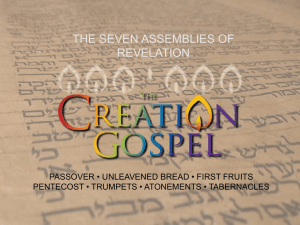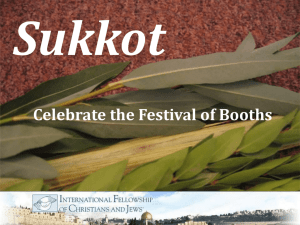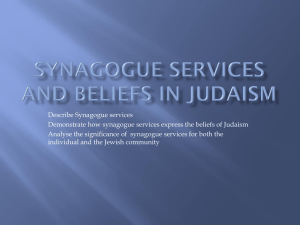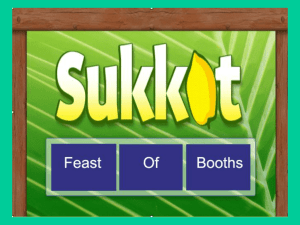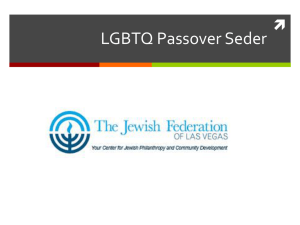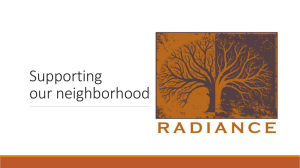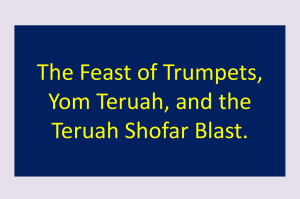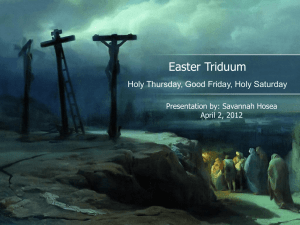The Jewish Calendar (PPT)
advertisement
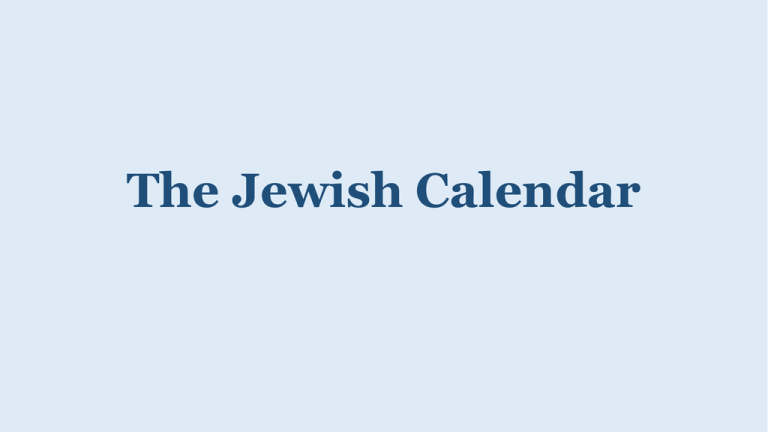
The Jewish Calendar Hebrew English Month Number Length of Month Gregorian equivalent נִיסָן ִאי ָר סִיוָן תַּ ּמּוז ָאב אֱלּול ׁשרי ִ ִת ׁשוָן ְׁ ֶח ִכ ְׁסלֵו ֵטבֵת ׁשְׁ בָט אֲדָ ר אֲדָ ר ()אֲ דָ ר ב׳ Nisan 1 30 days March-April Iyar 2 29 days April-May Sivan 3 30 days May-June Tamuz 4 29 days June-July Av 5 30 days July-August Elul 6 29 days August-September Tishri 7 30 days September-October Cheshvan 8 29 or 30 days October-November Kislev 9 30 or 29 days November-December Tevet 10 29 days December-January Shevat 11 30 days January-February Adar I (leap years only) 12 30 days February-March Adar (called Adar Beit in leap years) 12 (13 in leap years) 29 days February-March Nisan • Pesach • Yom HaShoah Pesach Date: Nisan 15-22 (falls in March or April of Gregorian calendar) Pesach is the festival of freedom. It commemorates Moses freeing the Israelites from their enslavement under the Pharaoh in Egypt. The festival lasts for eight days and during that time no 'leavened' food may be consumed. Jews who come from the Middle East, known as Sephardi Jews, will eat rice and pulses, but European Jews (known as Ashkenazi Jews) won't. Pesach Actions: On the first two nights of Pesach, a service known as a Seder is held here the story of the Passover and the Jewish exodus from Egypt is told, using a book called the Haggadah. At a Seder, it is customary for those attending to lean to their left to show that they are no longer bound by the restrictions of slavery imposed by the Pharaoh of Egypt and may sit however they please. Four cups of wine are also drunk during the service, and a celebratory meal is eaten. Pesach Home ritual/symbol: Preparation - The process of cleaning the home of all chametz in preparation for Pesach is an enormous task taking several weeks! After the cleaning is completed, the morning before the seder, a formal search of the house for chametz is undertaken, and any remaining chametz is burned. The day before Pesach is the Fast of the Firstborn, a minor fast for all firstborn males, commemorating the fact that the firstborn Jewish males in Egypt were not killed during the final plague. When Pesach occurs immediately after Shabbat... This complicates the process of preparing for Pesach, because many of the preparations normally undertaken on the day before Pesach cannot be performed on Shabbat. The Fast of the Firstborn, normally observed on the day before Pesach, is observed on Thursday instead. The search for chametz, normally performed on the night before Pesach, is performed on Thursday night. Pesach Symbol: • Chametz – or the avoidance of it! This commemorates the fact that the Jews leaving Egypt were in a hurry, and did not have time to let their bread rise. It is also a symbolic way of removing the "puffiness" (arrogance, pride) from our souls. We may not eat chametz during Pesach; we may not even own it or feed it to pets or cattle. All chametz, including utensils used to cook chametz, must either be disposed of or sold to a non-Jew (they can be repurchased after the holiday). Pets’ diets must be changed for the holiday, or the pets must be sold to a non-Jew (like the food and utensils, the pets can be repurchased after the holiday ends). • Seder plate – the seder plate holds at least six of the ritual items that are talked about during the seder: the shankbone, karpas, chazeret, charoset, maror, and egg. Pesach Pesach The Seder Plate explained: • A roasted lamb shankbone (zeroah) commemorates the paschal (lamb) sacrifice made the night the ancient Hebrews fled Egypt. Some people say it symbolizes the outstretched arm of God (the Hebrew word zeroah can mean “arm”). Instead of a bone, a roasted beet can be used. This isn’t a new idea; the great Biblical and Talmudic commentator Rashi suggested it back in the eleventh century. • A roasted egg (baytsah) is a symbol in many different cultures, usually signifying springtime and renewal. Here it stands in place of one of the sacrificial offerings which was performed in the days of the Second Temple. Another popular interpretation is that the egg is like the Jewish people: the hotter you make it for them, the tougher they get. This egg isn’t eaten during the meal; the shell just needs to look really roasted. • A bitter herb (maror) – horseradish is the most common. Bitter herbs bring tears to the eyes and recall the bitterness of slavery. The seder refers to the slavery in Egypt, but people are called to look at their own bitter enslavements, whether addiction or habit. • Charoset, which is the opposite of the maror. Charoset is a sweet mix of apples, nuts, wine and cinnamon which represents the mortar used by the Hebrew slaves to make bricks. Pesach The Seder Plate explained: • Karpas – a green vegetable, usually parsley (though any spring green will do). While karpas may symbolise the freshness of spring, others say people eat it to make them feel like nobility or aristocracy. Some families still use boiled potatoes for karpas, continuing a tradition from Eastern Europe where it was difficult to obtain fresh green vegetables. • Chazeret – a second bitter herb, most often romaine lettuce, but people also use the leafy greens of a horseradish or carrot plant. The symbolism is the same as that of maror. • Salt water – this symbolizes the tears and sweat of enslavement. Paradoxically, it’s also a symbol for purity, springtime, and the sea – the mother of all life. Often a single bowl of salt water sits on the table into which each person dips their karpas during the seder. Then, it’s traditional to begin the actual seder meal with each person eating a hardboiled egg (not the roasted egg!) dipped in the bowl of salt water. • Matzah – perhaps the most important symbol on the seder table is a plate that has a stack of three pieces of matzah (unleavened bread) on it, covered with a cloth. There are numerous interpretations for the three matzot. Some say they represent the Kohen class (the Jewish priests in ancient times), the Levis (who supported the priests), and the Israelites (the rest of the Jews). What symbolism you attribute to this trinity isn't all that important, as long as you’re thinking about it. • An orange – the orange is a recent addition to the seder plate and not one that is used in every Jewish home. It is a symbol that represents including women and homosexuals in Jewish tradition as both groups have often been marginalised. Pesach Other symbols at Pesach: During the struggles of Soviet Jewry, a fourth piece of matzah was added to the seder plate to symbolize the struggles of Jews who were not yet free enough to celebrate the Passover. Today, some families still use that fourth matzah as a way of remembering all people who are not yet free to celebrate as they wish. Wine cups and wine (or grape juice): Everyone at the seder has a (usually very small) cup or glass from which they drink four cups of wine. Traditionally, the four cups represent the four biblical promises of redemption: “I will bring you out from under the burdens of the Egyptians, and I will rid you from their slavery, and I will redeem you with an outstretched arm, and with great judgments. And I will take you to me for a people . . .” Others say the four cups represent the four letters in the unspeakable Name of God. Pesach Colour: Although there is no traditional colour, some consider the colour of Pesach to be brown. This is indicated by the roasted meat, the matzah, and the barley and wheat whose harvests are beginning. Brown is the colour of the desert and of Israel's parched summer landscape. The brown of Pesach is contrasted with the green of Sukkot six months later. Yom HaShoah Date: Nisan 27 (falls in April or May of Gregorian calendar) A day of commemoration for the approximately six million Jews who were killed in the Shoah (Holocaust). In Israel, it is a national memorial day. It was inaugurated in 1953. Yom HaShoah is held on the 27th of Nisan, unless the 27th would be adjacent to Shabbat, in which case the date is shifted back or forward by a day. Yom HaShoah Actions: Conservative and Reform communities have incorporated Yom HaShoah liturgies into their siddurim (prayerbooks). These liturgies typically include the lighting of a candle (often each member of the congregation lights one), modern poems, El Malei Rahamim (which is a funeral prayer from the Ashkenazi tradition) and the Mourner's Kaddish. Orthodox Judaism has taken an interesting, alternative stance. Orthodox Jews (as a general rule) do not mourn for victims of the Shoah on 27 Nisan because Judaism has specific laws prohibiting fasting and mourning in the month of Nisan, which is considered to be a month of happiness. Another view, is that contemporary Jews do not have the power to institute new days of mourning or commemoration for future generations. Orthodox Jews instead remember the Shoah on 10 Tevet, which is a fasting day. Yom HaShoah Symbol: Although there are no particular symbols associated with the actual day of Yom HaShoah, symbols of remembrance of the victims of the Holocaust are used year-round. These include transcriptions of lists of names of the victims and eternal flames, such as one that burns in the Hall of Remembrance (Ohel Yizkor) in Yad Vashem, Israel. Iyar • Yom Ha’atzmaut • Lag Ba’Omer Yom Ha’atzmaut Date: Generally 5 Iyar (falls in April or May of Gregorian calendar) Yom Ha’atzmaut is the national day of Israel, commemorating the Israeli Declaration of Independence in 1948. The original ‘Western’ date was the 14th of May, 1948. Yom Ha’atzmaut Actions: Conservative Judaism instituted the reading of a Torah portion for the day, Deuteronomy 7:12–8:18, as well as the inclusion of a version of Al Hanisim (a prayer for miracles, similar to those recited on Chanukah and Purim). Some Conservative synagogues also read the haftarah (reading from a prophet) of Isaiah 10:32–12:6, which is also read on the last day of Pesach in the Diaspora (the Jewish community outside of Israel). The Reform Movement usually includes Ya'aleh V'yavo, a prayer which is also included on Rosh Chodesh (the New Month), Shalosh Regalim (the Pilgrimage Festivals), Rosh Hashanah, and Yom Kippur. Yom Ha’atzmaut Home ritual/symbol: There is not yet an accepted "tradition" of how to celebrate this holiday. Over time, no doubt, certain customs, foods, prayers, and melodies will be linked in the Jewish mind with Yom Ha'atzmaut. However, for Jews around the world, joining with Israelis celebrating Yom Ha'atzmaut has become a concrete link in the Jewish connection to the land of Israel. Yom Ha’atzmaut Symbol: Synagogues, Jewish schools or community centres will sometimes host an Israel fair or concert. The traditional food on Yom Ha'atzmaut is Israeli food, such as pitta, fallafel and hummus. Yom Ha’atzmaut Colour: Blue and white – like the Israeli flag. In Israel, flags are hung from every available window and lamp-post. Lag Ba’Omer Date: 18 Iyar (falls in April or May of Gregorian calendar) Lag Ba'Omer is a joyous holiday but no one is quite sure exactly what it celebrates! Some suggest that Lag Ba'Omer is connected to Rabbi Akiva's support of Simon Bar Kokhba, a Jewish rebel leader against Rome. The Romans responded to Bar Kokhba's revolt with incredible brutality, but perhaps Lag Ba'Omer was a day when either the Jews won a victory or there was a brief respite from the violence. (Ultimately, Bar Kokbha's rebellion failed.) The Talmud also mentions a plague that is thought to have killed 24,000 of Rabbi Akiva's students during this time, and some have suggested that Lag Ba'Omer is celebratory because the plague abated on the 33rd day. It also celebrates the anniversary of the passing of the great sage and mystic Rabbi Shimon bar Yochai, author of the Zohar. Lag Ba’Omer Actions: Although the Counting of the Omer (the days between Pesach and Shavuot) is a semi-mourning period, this is lifted for Lag Ba’Omer. Tachanun, the prayer for special Divine mercy on one's behalf is not said, because when God is showing one a "smiling face," so to speak, as God does especially on the holidays, there is no need to ask for special mercy. Some synagogue schools have turned Lag B'Omer into a day for honouring their religious school teachers. Special assemblies and parties are held, and awards are often given to the teachers. Lag Ba’Omer Home ritual/symbol: Because all restrictions of mourning are lifted on Lag Ba’Omer, weddings, parties, listening to music, and haircuts are commonly scheduled to coincide with this day. Families go on picnics and outings. Children go out to the fields with their teachers with bows and rubbertipped arrows. People also often gather for large bonfires. Lag Ba’Omer Symbol: Bonfires - On Lag Ba’Omer, people often gather for large bonfires. The fires represent the light of the Torah. Bow and arrows – Two differing theories! 1) The legend that rainbows did not appear during the lifetime of Shimon Bar Yochai because he was such a good person. The word for "bow" in Hebrew is the same as the word for "rainbow," therefore children play with bows and arrows to remember Bar Yochai. 2) That the students of Rabbi Akiba deceived the Romans by carrying bows and arrows to pretend that they were hunting, when in fact they were studying Torah, which the Romans had forbidden. Sivan • Shavuot Shavuot Date: 6 Sivan (falls in May or June of Gregorian calendar) Shavuot is a harvest festival which also marks the giving of the Torah to Moses on Mount Sinai. The Book of Ruth is recited as part of the program of study for Shavuot night. Additionally, in many synagogues it is read publicly on the second day of Shavuot. Shavuot Actions: At synagogue services on Shavuot morning, the biblical book of Ruth is read. On the night of Shavuot, it is customary to study all night in Tikkun Leil Shavuot, which means “an act of self-perfection on the night of Shavuot”. Shavuot Actions: Why Ruth? Ruth was a non-Jewish woman whose love for God and Torah led her to convert to Judaism. The Torah intimates that the souls of eventual converts were also present at Sinai, as it says: “I am making [the covenant] both with those here today before the Lord our God, and also with those not here today.” (Deut. 29:13) Ruth also became the ancestor of King David. Tradition tells that King David was born on Shavuot and died on Shavuot. Finally, the scenes of harvesting described in the book of Ruth are appropriate to the Festival of Harvest. Shavuot Home ritual/symbol: • Eating dairy foods (often cheesecake) on Shavuot. There are four potential reasons for this: • The Biblical book Song of Songs (4:11) refers to the sweet nourishing value of Torah by saying: "It drips from your lips, like honey and milk under your tongue." • The verse in Exodus 23:19 juxtaposes the holiday of Shavuot with the prohibition of mixing milk and meat. On Shavuot, we therefore eat separate meals – one of milk and one of meat. • Upon receiving the Torah at Mount Sinai, the Jews immediately became obligated in the laws of Sh'chita – slaughter of animals. Since they did not have time to prepare kosher meat, they ate dairy instead. • The numerical value of milk – chalav – is 40. This hints to the 40 days that Moses spent atop Mount Sinai, and the 40 years the Jews spent wandering the desert. • Pilgrimage to the Western Wall in Israel. Following the Six Day War in 1967, the Western Wall first became open to visitors on the day of Shavuot. Over 200,000 visitors travelled there on foot. This has become a recurring tradition. Biblically, this tradition also has precedence. Shavuot is one of Judaism's three main pilgrimage festivals, where the entire nation would gather in Jerusalem for celebration and study. Shavuot Symbol: It is customary to decorate the synagogue with branches and flowers. This is because Mount Sinai blossomed with flowers on the day the Torah was given. Tamuz No holidays! Av • Tishah Be’Av Tisha B’Av Date: Generally 9 Av (falls in July or August of Gregorian calendar) The 9th of Av, Tisha b'Av, commemorates a list of catastrophes in Jewish history. Tradition holds that this day must therefore be a day specially cursed by God. Tisha B'Av is never observed on Shabbat. If the 9th of Av falls on a Saturday, the fast is postponed until the 10th of Av. Tisha B’Av History: • In the year 1313 BCE, the Israelites are in the desert, recently having experienced the miraculous Exodus, and are now poised to enter the Promised Land. That night, the 9th of Av, the people cry out of worry that they will be slaughered by the Canaanites. God, displeased by this public demonstration of distrust in God’s power, keeps that generation of Israelites from entering the Holy Land. Only their children have that privilege, after wandering in the desert for another 38 years. • The First Temple was also destroyed on the 9th of Av (423 BCE). • Five centuries later (in 69 CE), the Second Temple was destroyed the same day as the first. Tisha B’Av History: • When the Jews rebelled against Roman rule in 133 CE, the Jewish rebels were brutally butchered in the final battle at Betar on the 9th of Av. • One year after their conquest of Betar, the Romans plowed over the Temple Mount, the nation's holiest site. • The Jews were expelled from England in 1290 CE on Tisha B'Av. • In 1492, the Golden Age of Spain came to a close when Queen Isabella and her husband Ferdinand ordered that the Jews be banished from the land. The Hebrew date on which no Jew was allowed any longer to remain in the land was the 9th of Av. Tisha B’Av History: • World War II and the Holocaust is often considered by historians to be the conclusion of World War I that began in 1914. Germany declared war on Russia, setting the First World War into motion, on the 9th of Av. • During the Shoah, the first trains to go east to Auschwitz in 1942 did so on the eve of Tisha b’Av. Tisha B’Av Actions: Lights in the synagogue are dimmed, candles are lit, and the curtain is removed from the Ark. The cantor leads the prayers in a low, mournful voice. The Book of Eicha (Lamentations) is read both at night and during the day. In the morning, the Torah portion of Deuteronomy 4:25-40 is read, containing the prophecy regarding Israel's future iniquity and exile. This is followed by the Haftorah (reading from the Prophets) from Jeremiah (8:13, 9:1-23) describing the desolation of Zion. In the afternoon, Exodus 32:11-14 is read. This is followed by the Haftorah from Isaiah 5556. Since Tallis and Tefillin represent glory and decoration, they are not worn at Shacharit. Rather, they are worn at Mincha, after certain mourning restrictions are lifted. Prayers for comforting Zion are recited. Tisha B’Av is a fasting day. Tisha B’Av Home ritual/symbol: During the afternoon prior to Tisha B'Av, it is customary to eat a full meal in preparation for the fast. At the end of the afternoon, Jews eat the Seudah Hamaf-seket – a meal consisting only of bread, water, and a hard-boiled egg. The restrictions on Tisha B'Av are similar to those on Yom Kippur: to refrain from eating and drinking (even water); washing, bathing, shaving or wearing cosmetics; wearing leather shoes; engaging in sexual relations; and studying Torah. Work in the ordinary sense of the word [rather than the Shabbat sense] is also restricted. Many of the traditional mourning practices are observed: people refrain from smiles, laughter and idle conversation, and sit on low stools. Tisha B’Av Symbol: The egg in the Seudah Hamaf-seket meal has two symbols: The round shape reminds us of a sign of the cycle of life. Also, the egg is the only food which gets harder the more it is cooked – a symbol of the Jewish people's ability to withstand persecution. Food eaten at the Seudah Hamaf-seket (the meal above) is dipped in ashes, symbolic of mourning. The meal should preferably be eaten alone, while seated on the ground in mourner's fashion. Tisha B’Av Colour: The ark (the special cabinet where the Torah is kept) is draped in black. Elul No holidays! Tishri • Rosh Hashanah • Yom Kippur • Sukkot • Simchat Torah Rosh Hashanah Date: 1 Tishri (usually falls in September of Gregorian calendar) Rosh Hashanah is commonly referred to as the Jewish New Year. On Rosh Hashanah, God writes the fate of each person for the coming year into the “book of life”. God waits until Yom Kippur (10 days later) to ‘seal’ this fate. Rosh Hashanah Actions: On the first day of Rosh Hashanah, Genesis 21 is read – Isaac’s birth and his growth to manhood; Abraham’s banishment of Ishmael; and Abraham’s peace treaty with Abimelech. This portion is chosen for Rosh Hashanah because Isaac was born on Rosh Hashanah. The Haftarah (reading from the Prophets) on the first day of Rosh Hashanah is from the first part of the Book of Samuel. Genesis (22: 1-24) is read on the second day. It deals mainly with the binding of Isaac. Abraham obeys the voice of God and offers Isaac as a sacrifice; Isaac willingly complies. The second day’s Haftarah is from the Book of Jeremiah. Prayers at Rosh Hashanah are read from a special prayerbook called a Machzor. Hallel (joyful psalms of praise to God) are not said on Rosh Hashanah - it is felt inappropriate to say Hallel during the Days of Awe when we are very conscious that God is sitting in judgment over us. Rosh Hashanah Home ritual/symbol: • Eating sweet foods! It is customary to eat apples dipped in honey. The apples remind Jews of the ‘roundness’ of the year and the hope that the coming year will be fruitful. The honey represents the wish for a sweet year. Sweet carrots, cooked with sugar, raisins or prunes are served with the Rosh Hashanah meal, again in the hope of a sweet year. • Eating pomegranate – a pomegranate is said to have 613 seeds, which corresponds with the number of mitzvot (commandments or good deeds) in the Torah. Eating pomegranate on Rosh Hashanah shows a hope that we will perform all the mitzvot of the Torah during the coming year. • Sending Rosh Hashanah cards to wish others a happy and sweet new year. A common greeting on Rosh Hashanah is: “L’shanah tovah tikateivu” – “May you be inscribed (in The Book of Life) for a good year”. Rosh Hashanah Symbol: The shofar is the most important symbol of Rosh Hashanah. It is a horn or trumpet made from the horn of a kosher animal (but not from a cow – that would be associated with the sin of the Golden Calf). The shofar is sounded on both days of Rosh Hashanah, a minimum of 30 times (but commonly 100 times or 101 times). The Shofar is blown using four different calls: • Tekiah – one long sound • Shevarim – three shorter blasts • Teruah – nine fast toots • Tekiah Gedolah – a sustained blast, if possible 27 beats long The Shofar is NOT sounded if it is also Shabbat. Rosh Hashanah Colour: On Rosh Hashanah, many Jews wear white as a symbol of purity. The curtain across the ark and the Torah covers are also white. They show that mistakes will be “whitened like snow”. Yom Kippur Date: 10 Tishri (falls in September or October of Gregorian calendar) Yom Kippur (also known as the ‘Day of Atonement’) marks the end of the Ten Days of Repentance. These days begin with Rosh Hashanah, the Jewish New Year. On Rosh Hashanah, God writes the fate of each person for the coming year into the “book of life”. God waits until Yom Kippur to ‘seal’ the fate. Yom Kippur is the holiest day of the Jewish calendar – it is considered ‘Shabbat Shabbaton’ – the Sabbath of Sabbaths (Leviticus 23:32). Scripture link: "For on this day He will forgive you, to purify you, that you be cleansed from all your sins before G-d" (Leviticus 16:30). Yom Kippur Actions: There is a prohibition to engage in the five Innuyim ("afflictions“). This prohibits Jews from eating and drinking, washing one’s body, anointing one’s body, wearing leather shoes and engaging in sexual intercourse during the 26 hours of Yom Kippur. These things aren’t considered ‘bad’ or ‘sinful’, nor is it a punitive measure to prohibit these activities. Rather, the five afflictions are all external things concerned with the body, rather than the soul. Atonement is ‘at-one-ment’ – returning to one’s self (in the form of the inherent purity of one’s soul). On Yom Kippur, every Jew becomes like an angel – a completely spiritual being, closer to God because of the lack of earthly distraction. Yom Kippur Home ritual/symbol: • Because fasting on Yom Kippur is not supposed to be about punishment or suffering, it is considered a mitzvah (commandment) to eat well on the day before Yom Kippur. Therefore, the final meal before Yom Kippur should be a joyful one. At the end of the meal, children are blessed by their father with a special blessing. • Before leaving home to go to the Kol Nidre service at synagogue, Jews light a memorial (yahrzeit) candle. This candle burns in the home for 24 hours. It reminds Jews of all those people who have died, in individual families and in the world. After Yom Kippur has finished, the yahrzeit candle is used to light the havdalah candle as part of the havdalah ceremony to mark the end of the day. Yom Kippur Symbol: The number five is strongly connected with Yom Kippur and atonement. • There are five afflictions (prohibited activities for Yom Kippur day) • There are five Books of the Torah which are accepted without allowing physical needs to intervene • There are five senses with which people performs mitzvot (obligations) and commit transgressions • The term nefesh (soul) is mentioned five times in the Yom Kippur Torah reading • At the time of the Temple, there were five immersions of the Kohen Gadol (High Priest) on Yom Kippur • There are five prayer services on the Yom Kippur day Yom Kippur Colour: On Yom Kippur, many Jews wear white as a symbol of purity. The curtain across the ark and the Torah covers are the white ones that have been used since Rosh Hashanah. They continue to show that mistakes will be “whitened like snow”. Sukkot Date: 15 Tishri (falls in September or October of Gregorian calendar) For forty years, the Israelites wandered the Sinai Desert prior to their entry into the Holy Land, miraculous "clouds of glory" surrounded and hovered over them, shielding them from the dangers and discomforts of the desert. Sukkot commemorates God's kindness and reaffirms Jewish trust in God’s providence by dwelling in a sukkah – a hut of temporary construction with a roof-covering of branches – for the duration of the autumn Sukkot festival. During the Festival of Sukkot, for seven days and nights, Jews eat all meals in the sukkah, recite a special blessing and otherwise regard it as their home. Sukkot Actions: On each day of the festival (except Shabbat), during the daytime hours, we take the Four Kinds, recite a blessing over them, bring them together in our hands and wave them in all six directions: right, left, forward, up, down and to the rear. (The Four Kinds are also an integral part of the holiday's daily morning service.) Every day of Sukkot, including Chol Hamoed, we recite the complete Hallel, Hoshanot, and Musaf, and the Torah is read during the morning service. The seventh day of Sukkot is called Hoshanah Rabbah ("Great Salvation"). According to tradition, the verdict for the new year – which is written on Rosh Hashanah and sealed on Yom Kippur – is not handed down until Hoshanah Rabbah. On this day we encircle the bimah (synagogue reading table) seven times while holding the Four Kinds and offering special prayers for prosperity during the upcoming year. During the course of the morning prayers it is also traditional to take a bundle of five willow branches and beat them against the ground five times. Sukkot Home ritual/symbol: Sukkot runs from the 15th through the 21st of Tishrei. The first two days of this festival (in Israel, only the first day) are a major holiday, when most forms of work are prohibited. On the preceding nights, women and girls light candles, reciting the appropriate blessings, and we enjoy nightly and daily festive meals, accompanied by the Kiddush. The remaining days of the festival are Chol Hamoed ("intermediate days"), when most forms of work are permitted. We try to avoid going to work, writing, and certain other activities – many families use this time to enjoy fun family outings. Arba Minim is a man's obligation. For women, it's optional but encouraged. Sukkot Symbol: The Arba Minim – the Four Kinds: A palm branch (lulav), two willows (aravot), a minimum of three myrtles (haddasim), and one citron (etrog). The first three kinds are neatly bundled together. Jewish unity is one of the central themes of Sukkot. The four kinds are supposed to symbolise four types of Jews, with differing levels of Torah knowledge and observance. Bringing them together represents our unity as a nation—despite our external differences. Sukkot Colour: The colour of Sukkot is green, indicated by the colours of the Four Kinds (including the etrog, which ripens from green to yellow), and of the green branches covering the sukkah. Green is also the colour of Israel's lush, rain-drenched winter landscape. Sukkot finds itself on the opposite side of the Jewish calendar as Pesach. As such, the green, lush landscape of Sukkot represents the opposite of the brown, parched landscape of the time of Pesach. Simchat Torah Date: 22 Tishri (falls in September or October of Gregorian calendar) Sukkot is immediately followed by the holiday of Simchat Torah. At Simchat Torah, death and life are closely linked. The Torah reading cycle reaches its final episode at the end of Deuteronomy, the death of Moses. Just a moment later, the cycle is restarted “In the beginning”, affirming life through Bereshit (Genesis), the Creation of the world. Simchat Torah Actions: The main celebration of Simchat Torah takes place in the synagogue during evening and morning services. The Simchat Torah festivities begin with the evening service. All the synagogue's Torah scrolls are removed from the ark and are carried around the sanctuary in a series of seven hakafot (circuits). The dancing and singing with the Torah often continues much longer, and may overflow from the synagogue onto the streets. In the morning, the last parashah of Deuteronomy and the first parashah of Genesis are read in the synagogue. On each occasion, when the ark is opened, all the worshippers leave their seats to dance and sing with all the Torah scrolls in a joyous celebration that often lasts for several hours and more. Simchat Torah Symbol: The Torah - The Torah scrolls are placed proudly on show. The Torah is honoured, kissed, turned to, and passed lovingly around. The number seven - All the synagogue's Torah scrolls are removed from the ark and are carried around the sanctuary in a series of seven hakafot (circuits). These seven circuits are reminiscent of the seven circles at a wedding, symbolising the joining together of a couple which continues the work of Creation, completed in seven days. Cheshvan No holidays! Kislev • Chanukah Chanukah Date: 25 Kislev (falls in December of Gregorian calendar) Chanukah celebrates the ‘miracle of the oil’ and marks the rededication of the Temple of Jerusalem after its recapture from the Syrian Greeks 165 BCE. The legend of a miracle is recorded in the Talmud – the burning of a day's supply of pure olive oil for eight days, until fresh jars of clean oil could be brought into the temple. The Book of Second Maccabees, one of the earliest sources on the origins of Chanukah, connects the eight days of the festival with the eight-day observance of Sukkot. According to the text, the first Chanukah in 164 BCE was celebrated as a delayed Sukkot, since the Maccabees had been unable to observe the holiday properly while they were fighting in the hills. Chanukah Actions: Jews don’t need to go to synagogue because Chanukah is celebrated at home. However, there is often a synagogue (or community) celebration on the first night of Chanukah. There is also often a special service at the synagogue on the first night and/or eighth night of Chanukah. Chanukah Home ritual/symbol: Every community has its unique Hanukkah traditions, but there are some traditions that are almost universally practiced: • Lighting the chanukkiyah – the chanukkiyah is lit every night for eight nights. The idea is, each night, to bring more light into the world. • Spinning the dreidel – a popular Chanukah game is spinning the dreidel, which is a four-sided top with Hebrew letters written on each side. • Eating fried foods – because Hanukkah celebrates the miracle of oil, it is traditional to eat fried foods such as latkes and sufganiyot during the holiday. Chanukah Symbol: • Chanukkiyah • Light • The Dreidel, with the Hebrew letters ( נNun) ( גGimel) ( הHei) ש (Shin), which together form the acronym for “Nes Gadol Hayah Sham” – “a great miracle happened there”). • Chocolate coins for children – ‘Chanukah gelt’ • Oily foods – latkes (potato pancakes), sufganiyot (jelly donuts) Chanukah Colour: There are no traditional, biblical colours for Chanukah. However, because of the influence of Christmas (and the fact that Christmas has traditional colours), the colours of the Israeli Flag (blue and white) are used as Chanukah colours. This practice is only about 40 years old. The blue and white (or sometimes silver) that are often seen in Chanukah decorations represent Judaism in general. In ancient times, a blue dye called tekhelet was very sought after, and became one of the colours in Jewish prayer shawls and in the Israeli flag. Tevet No holidays! Shevat • Tu B’Shevat Tu B’Shevat Date: 15 Shevat (falls in January or February of Gregorian calendar) Tu B’Shevat (meaning the 15th of Shevat) is the ‘New Year for Trees’. This is the season in which the earliest-blooming trees in Israel begin a new fruit-bearing cycle. It is a minor post-biblical festival. As there are a number of rules in the Torah apply to the fruit of trees, such as tithing, Tu B’Shevat is, essentially, an ‘accounting period’ - the point at which a budding fruit is considered to belong to the next year of the cycle is the 15th of Shevat. Tu B’Shevat Actions: We mark the day of Tu B’Shevat by eating fruit, particularly from the kinds that are singled out by the Torah in its praise of the bounty of the Holy Land: grapes, figs, pomegranates, olives and dates. On this day we remember that each human is “a tree of the field” (Deuteronomy 20:19), and reflect on the lessons we can derive from nature and biology. Jews typically take part in a Tu Be’Shevat seder – either at home or in a community seder at a synagogue. As Tu B’Shevat is a festival of trees, at this seder, Jews drink four cups of wine or grape juice, plus 15 different types of fruits and nuts. Tu B’Shevat Home ritual/symbol: There is a very strong tradition of donating money to buy trees in Israel, so as to enrich the soil and to prevent erosion as well as to provide fruit and shade. Another variant of this tradition is to plant trees in one’s own country, which can be combined with honouring famous people or deceased relatives. Tu B’Shevat Symbol: Fifteen is the numerical value of the Hebrew letters spelling “TU” (Tet and Vav). For this reason, 15 different types of fruit and/or nut are eaten on Tu B’Shevat. These fruits and nuts are typically things that grow in Israel. Five from each ‘category’ is eaten: • Fruits or nuts with an inedible outer shell and an edible inner core. These include pineapple, coconut, orange, banana, walnut, pecan, grapefruit, starfruit, pinenut, pomegranate, papaya, brazil nut, pistachio, or almond. (The whole fruit or nut is purchased so that the outer shell can be removed during the seder). • Fruits with edible outer flesh and pithy, inedible cores. These include olive, date, cherry, peach, apricot, persimmon, avocado or plum. (The whole fruit is purchased so that the pit or core can be removed during the seder). • Fruits which are edible throughout. The symbolic fruits may be eaten entirely and include: strawberry, grape, raisin, fig, raspberry, blueberry, cranberry or kiwi. Adar • Purim Purim Date: 14 Adar (falls in February or March of Gregorian calendar) Purim recalls the story of Esther, a Queen who foiled a plot by one of her advisors, Haman, to kill all the Jews. Purim is such a popular holiday that the ancient Rabbis declared that it alone would continue to be celebrated after the Messiah comes! All other holidays will not be celebrated in the messianic days. Purim Actions: The Scroll of Esther (also called the Megillah) is read in synagogue. During the reading, whenever Haman’s name is mentioned, people boo, howl, hoot and shake noisemakers (called groggers) to express their dislike of him. Hearing the Megillah reading is a mitzvah that applies to both women and men. At the conclusion of the Megillah reading, many synagogues will put on plays that re-enact the Purim Story and poke fun at the villain. Many synagogues also host Purim Carnivals. Purim Home ritual/symbol: Jews must send mishloach manot to others. Mishloach manot are baskets filled with food and drink. According to Jewish law, each basket must contain at least two different kinds of food that is ready to eat. Jews are also commanded to be especially charitable during Purim, giving to charities and needy people. On Purim, Jews are supposed to enjoy a festive meal as part of the holiday celebration. After the meal, pastries called Hamentaschen (‘ears of Haman’) are eaten - these are triangular and filled with poppy seeds, jam or fruit. One of the most interesting commandments related to Purim has to do with drinking. According to Jewish law, adults of drinking age are supposed to drink until they can't tell the difference between Mordechai (a hero in the Purim story) and Haman (the villain). Purim Symbol: Purim is a day for parties and celebrations, and fancy dress is traditional. Even the Rabbi will dress up in a silly costume for the service! The tradition of dressing up is based upon the way Esther concealed her Jewish identity at the beginning of the Purim Story. On Purim, the wine (or other alcohol) itself is not symbolic. Therefore, the nature of the obligation is not defined by volume, but rather, by the effect upon the drinker.
